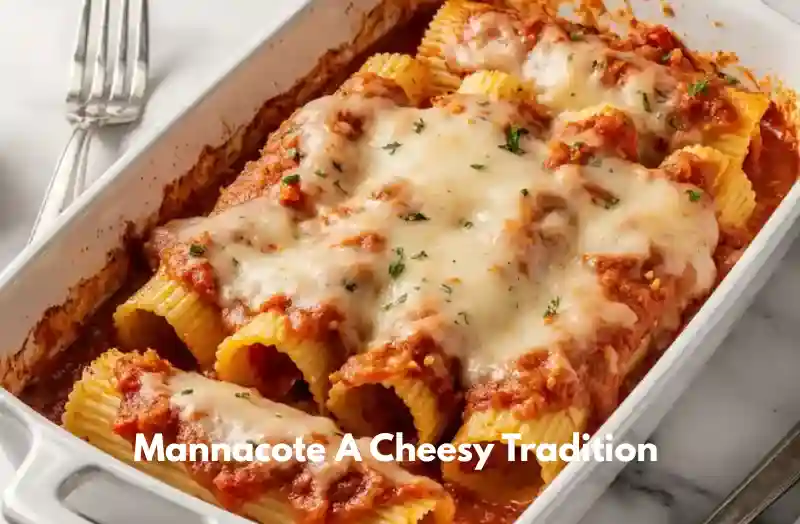There is something deeply comforting about sitting down to a plate of rich baked pasta filled with creamy cheese and covered in bubbling tomato sauce. Known in many Italian-American households as Mannacote this dish is more than a meal—its a piece of cultural heritage served with love. Born from the fusion of Italian tradition and American adaptation it captures the essence of home-cooked comfort. Its flavors are familiar its texture indulgent and its aroma irresistible. Whether its served during Sunday family dinners or brought out for special gatherings it has a way of turning an ordinary meal into a celebration.
From Southern Italy to American Tables
The origin of this beloved dish goes back to southern Italy where cooks filled delicate pasta sheets with meats cheeses and herbs then rolled them up and baked them in tomato sauce. This preparation was known as cannelloni. When Italian immigrants brought their culinary traditions to America fresh pasta sheets were hard to come by so dry pasta tubes were used instead.
These changes led to what we now know as manicotti. In many Italian-American families it was affectionately referred to as Mannacote reflecting regional dialects and generational storytelling. Over the years it became a staple of immigrant kitchens a symbol of resourcefulness and a taste of home in a new land.
Filling That Warms the Soul
The core of this dish lies in its filling—typically a smooth blend of ricotta cheese grated Parmesan mozzarella egg and herbs like parsley or basil. Depending on the family recipe you might also find additions like cooked spinach sautéed mushrooms or a touch of nutmeg for warmth. The pasta shells firm enough to hold their shape but tender after baking are gently stuffed with this rich filling and nestled into a bed of marinara sauce. Once topped with more sauce and a layer of cheese the dish is baked until everything is melty golden and deeply satisfying.
Each bite offers a perfect blend of textures—soft pasta creamy filling and crispy cheese edges. Its simple food but the kind that feels luxurious.
Bringing It to Life in Your Kitchen
Making this classic comfort dish at home may sound elaborate but the steps are wonderfully approachable. Start by boiling the pasta tubes just until al dente. As they cool prepare the filling by combining your cheeses eggs and herbs. For an extra layer of flavor a touch of garlic or lemon zest works wonders.
Use a piping bag or small spoon to gently fill each tube then place them in a baking dish with a generous base of tomato sauce. Add more sauce over the top sprinkle with shredded cheese cover with foil and bake until everything is hot and bubbling. Uncover toward the end for that perfectly browned top layer. The result is a pan of food that smells like comfort and tastes like nostalgia. Its ideal for feeding a crowd and even better as leftovers the next day.
Why This Dish Still Resonates
There a reason why this humble baked pasta continues to win hearts across generations. Its not just the taste—its the emotion tied to it. For many it brings back memories of family dinners grandparents in the kitchen or special holidays where tradition met flavor. Its adaptability is also part of its charm. Whether you stick to the classic version or put your own twist on it with different cheeses sauces or proteins it remains deeply satisfying. Its a forgiving recipe that encourages experimentation while holding onto its comforting core.
And above all it speaks to the power of food to connect people—across cultures across generations and across dinner tables.
Where to Experience Its Roots
Though homemade versions are deeply personal you can find delicious renditions in Italian-American neighborhoods and restaurants across the U.S. In places like Boston North End New Yorks Little Italy or South Philly’s Italian Market family-run eateries still serve traditional baked pasta dishes based on time-honored recipes.
These spots often rely on methods passed down for generations using fresh cheeses slow-simmered sauces and a commitment to authenticity. Eating this dish at one of these restaurants can feel like stepping into some ones family kitchen.
How It Stands Apart
Its often compared to cannelloni baked ziti or lasagna—and while there are similarities this dish has its own charm. Unlike lasagnas with many layers or baked ziti’s casserole style this is neatly portioned. Each stuffed shell is its own little pocket of joy delivering concentrated flavor in every bite. Cannelloni typically uses rolled fresh pasta while this version uses dry pasta tubes—making it more accessible and weeknight-friendly without sacrificing authenticity or comfort.
Its Tasty and Nourishing Too
Despite its reputation as indulgent this baked pasta can be surprisingly balanced. Ricotta offers protein and calcium marinara sauce is rich in lycopene and other antioxidants and fresh herbs bring added nutrients and flavor. Swap in whole-wheat pasta for more fiber use part-skim cheeses and load up the filling with veggies like spinach kale or roasted peppers. It becomes a wholesome feel-good meal—proof that tradition and nutrition can go hand in hand.
The Cultural Importance Behind the Recipe
This dish isn’t just a recipe—its a story. It represents the journey of Italian immigrants adapting to new surroundings while preserving old traditions. Its the fusion of resourceful cooking and generational love. Passed from grandparents to parents to children it keeps family heritage alive one delicious tray at a time. In the world of Italian-American cuisine few dishes are as iconic. It celebrates family flavor and the beauty of keeping tradition on the dinner table—even as times change.
Final Thoughts and a Bit of Guidance
Whether you grew up with it or are making it for the first time this dish has a way of making you feel at home. It does not demand perfection—just intention and care. Thats what makes it so beloved. If you’re unsure where to begin or want to explore other classic Italian-American dishes consider reaching out to experienced home cooks or enrolling in a cooking class. Learning from someone who been making it for years offers insights that no recipe card can.
Frequently Asked Questions
Is it the same as manicotti
Yes Mannacote is a regional pronunciation of manicotti often heard in Italian-American families.
Can I prepare it in advance
Absolutely. Assemble and refrigerate for up to two days or freeze for longer storage.
Can I make it vegetarian or gluten-free
Easily. Use gluten-free pasta tubes and keep the filling meat-free for a vegetarian option.
Whats the best cheese to use
Ricotta is traditional but a blend of ricotta mozzarella and Parmesan creates the most flavorful result.
Do I need homemade sauce
Store-bought sauce works but a homemade version adds depth and a personal touch.
Conclusion
If you’re a home cook exploring Italian-American cuisine or just learning how to bring more traditional dishes into your kitchen seeking guidance can elevate your experience. Whether you’re unsure about cheese blends sauce pairings or wine selections a quick consultation with an experienced Italian-American cook can save hours of guesswork. You don’t need to be a chef—just passionate. Consider reaching out to food forums community cooking classes or even your Nonna for advice. Sometimes the best culinary guidance comes from someone who’s been making Mannacote for decades right in their own kitchen.



